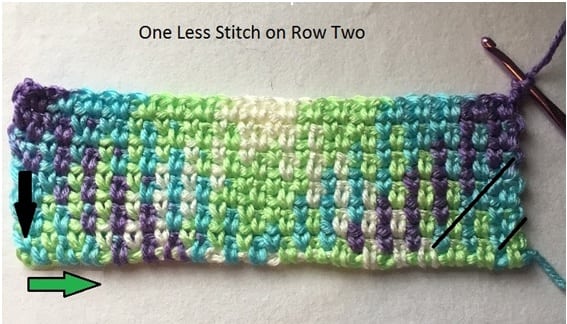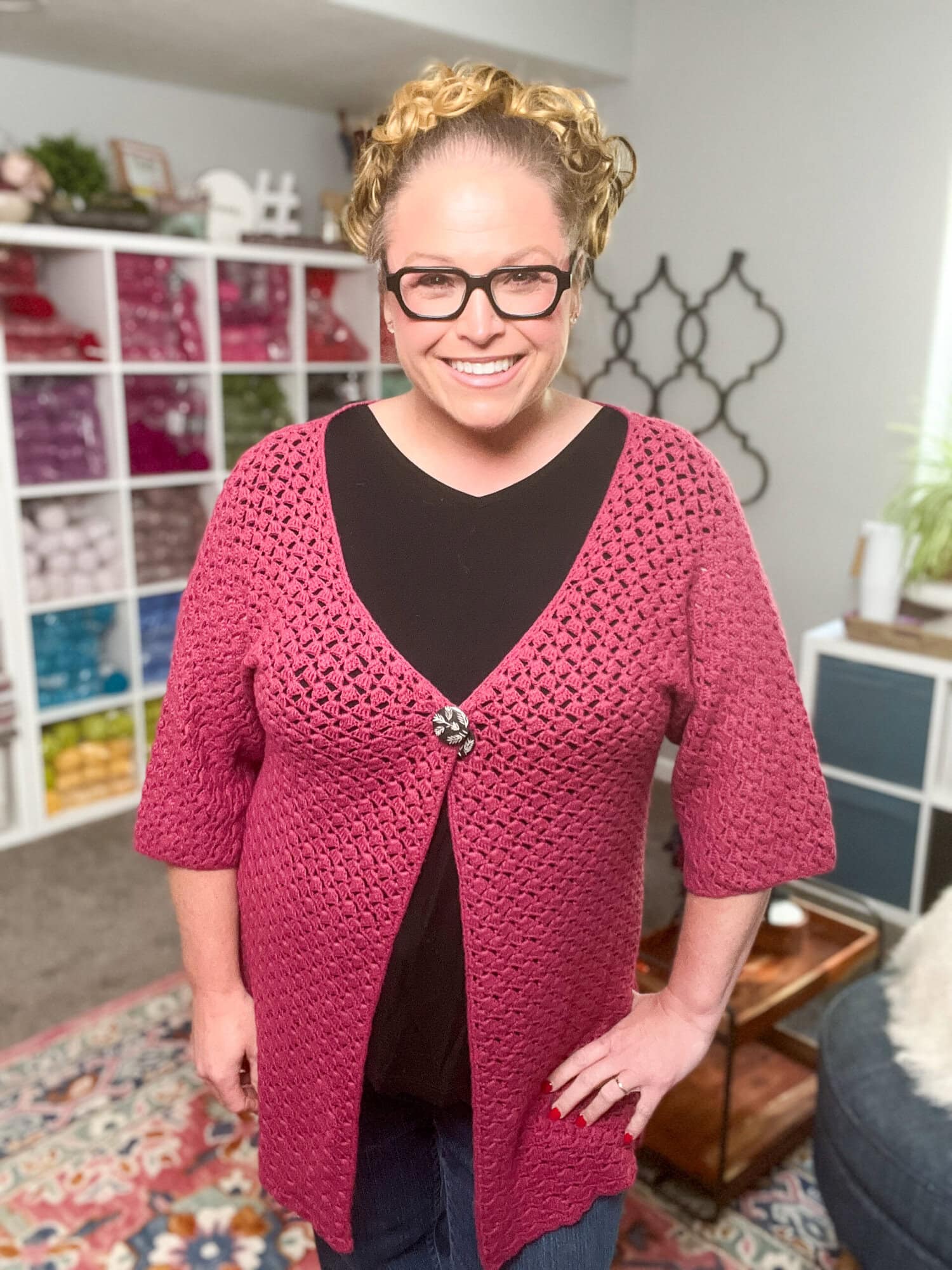Planned Pooling Crochet: Planned Pooling Color Placement
 Today we have a special guest on the blog. Please welcome back Brenda-Leigh who is here today to teach us about planned pooling color placement and dominate color selection.
Today we have a special guest on the blog. Please welcome back Brenda-Leigh who is here today to teach us about planned pooling color placement and dominate color selection.
When you are starting a planned pooling project and using a new color, it is always best to do a swatch first. I know, I know – we all hate doing a gauge swatch, but trust me, you want to do one for your pooling projects. There are 3 reasons why making a swatch is worth the time in a pooling project.
Three Reasons Why to Swatch in Planned Pooling Crochet:
- Choosing the best hook size
- Choosing the color placement
- Deciding where to create your offset
In order to get the best results from your planned pooling project you will want to work through these three reasons in order. Each reason for making a swatch first builds off of the knowledge you learn in the previous reasons. This tutorial will address choosing planned pooling color placement and dominate color selection. Be sure to look out for the last reason in our series to swatch for planned pooling coming to the blog soon!
*This post contains affiliate links. By clicking one of these links and making a purchase a small portion of your purchase will go to the blog, but the price you pay will not change. Thank you for your support of the blog.*
Tutorial Materials:
For this tutorial, I will be using Red Heart Soft Baby Steps in Tickle. Making a swatch for planned pooling isn’t quite the same as making one to check gauge, yet they both have a purpose and provide valuable information before starting a project. Because a planned pooling swatch and a gauge swatch serve two different purposes we came up with three reasons to swatch series to help you understand the purpose.
In part one I choose the 4 mm (G) Susan Bates crochet hook and created this fabulously wobbly swatch, pictured below. I am using the Susan Bates Silvalume crochet hook set, as they are my favorite and I find the finish moves very smoothly through any yarn.
Using your swatch to pick the dominate color:
Before you can work on color placement you will need to determine the dominate color for your project. To accomplish this I will be using my swatch from the last time, picking the right hook size, to get the answers to my question.
Looking at the swatch on the left I will determine which color stands out to me the most. You should do the same thing with your swatch to figure out what color speaks to you in your yarn choice. This is a very personal thing that no one else can choose for you.
To get a clear picture of the colors it is best to set your hook down and back away from the crochet. I suggest you give some space because it is often easier to see a the dominate color from a few feet away. Or take a picture with your camera if you don’t have the space to back away. What color do you see first/more, that is your dominant color.
After Picking Your Dominate Color:
Now that I’ve decided on purple as my dominant color, I want to plan how it will look in my project. As you work through the colors, every stitch will be the first stitch in the row at some point. If you recall from my last post on Choosing the Best Hook Size, I was able to get three stitches from each color. I can decide if I want to start my row on the first purple stitch, the second purple stitch, the third purple stitch, the first blue (after purple), the second blue (after purple), etc.
Not all colors move the same way for all crocheters. On the Planned Pooling Facebook page we often see people say the new color on your hook has to come before that same color two rows below. Others are adamant that it must come after. The truth is there are a number of things that will influence where your colors land.
To set up pooling in moss stitch, you need to add or remove one stitch every other row. This is why the turning chain sometimes counts as a stitch and sometimes doesn’t. Most tutorials have you removing a stitch on row one. My previous post about Multiple Sequence Pooling has you set up the offset at the end of row two.
Four options to set up the offset:
- One Less stitch on row one
- One Less stitch on row two
- One Extra stitch on row one
- One Extra stitch on row two
It is important to note here that when we say add or remove a stitch, we are not altering the total stitch count for the row. A more proper way to say this might be to work an extra stitch in one color or to work one fewer in one color. Part three of this tutorial will address choosing a color for the offset, which may help this concept become more clear to you.
I would recommend you try each of these options to find the one that best suits you. My preference is to add one stitch on row two, but that is just what makes my brain happy. I’m going to show you all four options here using the same yarn, same hook size and always starting in the same place within the sequence.
Setting up the offset-One Less Stitch on Row One:
The green arrow indicates my starting position. You will see that in my color sequence I have 3 blue, 3 purple, 3 blue, 2 green, 3 white, 3 green.
The black arrow pointing up shows where I did two sc in one space. The black arrow pointing down shows the next time I used up yarn in the same manner.
It is quite noticeable so you can easily see it. Notice how the starting blue moves directly away from the corner towards the center.
Setting up the offset-One Less Stitch on Row Two:
My starting position is denoted again by the green arrow in the picture. By using this offset it is causing me to have 3 blue, 3 purple, 3 blue, 3 green, 3 white, 3 green stitches. The black arrow shows the blue stitch following only 2 green.
I have marked the blue on the opposite side for clarity, but as you can see it is moving toward the edge, rather than the center.
Setting up the offset-One Extra Stitch on Row One:
The green arrow indicates my starting position. I numbered the white stitches here because they are harder to understand.
The black arrow is pointing to one that is half green and half white (it is all white on the other side and I was fooled). So my extra stitch is really between the green and white.
Again, notice the starting blue moves to the edge before coming back to the center.
Setting up the offset-One Extra Stitch on Row Two:
Again my starting position is denoted by the green arrow. You will notice that I have 3 blue, 3 purple, 3 blue, 3 green, 3 white, 3 green. The black arrow shows the fourth white stitch. As you can see this causes the starting blue to move from the corner to the center.
Planning your Pooling:
So, now you have chosen your dominant color and, based on how you do your offset, you know how your color will travel in your project.
- Do you want your dominant color to move from the corner to the center?
- Would you rather it to form a solid half square in the corners?
- Do you want it to start in the middle of your project and move outward?
This is where the real planning of planned pooling comes into play. We all know where you start won’t affect your ability to pool a yarn, but it certainly has an influence on what your finished product looks like.


Here is a swatch of one full color sequence. You will see that one has a large purple X and the other a large purple diamond. Maybe, you find the white as dominant, in which case you will see the one swatch has a large white X and the other a large white diamond.
Now that you understand how your offset method effects the color movement within your project, you can start with the design you like best. A little extra time in planning makes a big difference in the beauty of the finished project.
Planned Pooling Crochet Blog Posts with Marly Bird:
Thanks so much to Brenda-Leigh for sharing with us planned pooling color placement and picking your dominate color. If you want to learn more about Crochet Planned Pooling you can view my other posts on the topic.
- The Best Crochet Planned Pooling Argyle Tutorial
- 10 Secrets to Perfect Planned Pooling in Crochet
- Planned Pooling-Finished Starting Chains
- How to create Crochet Planned Pooling Argyle Charts
- Multiple Sequence Planned Pooling Crochet
- Granny Stitch Planned Pooling Crochet
- Planned Pooling Crochet: Choosing the Best Hook Size
About Brenda-Leigh:
My name is Brenda-Leigh and I taught myself how to knit when I was seven using a book. Shortly after I began knitting my mother wanted to learn as well so I taught her. It was a great bonding experience to be able to show her something I had learned.
When I was eleven I taught myself how to crochet and my first project was a pineapple doily made with crochet thread.
I’ve continued with both over the years and have recently fallen in love with crochet. When planned pooling became popular last fall, I caught on right away and have had to opportunity to teach others. Since that early experience with my mother, I’ve loved being able to teach others and witness their success. Nothing makes me happier than giving someone that “aha!” moment.
You can find me on Ravelry as CrochetbyAlexina.
Yarn Pooling Made Easy by Marly Bird:
Did you know that Marly has published a book on Planned Pooling Crochet? In this book, published by Leisure Arts, you will find 10 beautiful designed patterns that you can create using Red Heart yarns.




















DOMINANT, not dominate. Someone needs to correct the multiple appearances of the latter.
I want to do the planned pooling with RHSS Macaw.. does anyone know if this will work for this yarn?